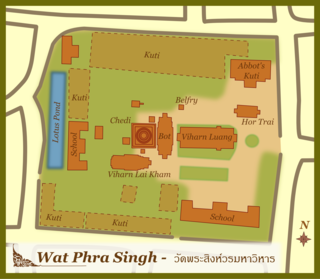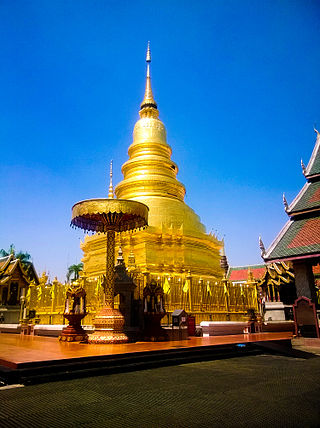
Chiang Mai is the largest city in northern Thailand, the capital of Chiang Mai province and the second largest city in Thailand. It is 700 km (435 mi) north of Bangkok in a mountainous region called the Thai highlands and has a population of 1.2 million people as of 2022, which is more than 66 percent of the total population of Chiang Mai province.

Phayao is one of Thailand's seventy-seven provinces (changwat), and lies in upper northern Thailand. Neighboring provinces are Nan, Phrae, Lampang, and Chiang Rai. To the northeast it borders Xaignabouli in Laos.

Wat Chedi Liam, formerly known as Wat Ku Kham, is one of the wats in the ancient Thai city of Wiang Kum Kam, now part of present-day Chiang Mai.

Wat Phra That Doi Chom Thong is located in Nakhon Chiang Rai, Amphoe Mueang, Chiang Rai Province, Thailand.

Wat Phra Sing, or sometimes spelled etymologically as Wat Phra Singh, is a Buddhist temple located on Tha Luang Road in Tambon Wiang, Mueang district, Chiang Rai Province in northern Thailand.

Wiang Kum Kam is an historic settlement and archaeological site along the Ping River, which was built by King Mangrai the Great as his capital before he moved it to Chiang Mai. It was flooded and abandoned more than 700 years ago; that move became more understandable in 2005, when the ancient city was flooded three separate times as the river overflowed its banks in that area of Chiang Mai.

Wat Phra Singh is a Buddhist temple in Chiang Mai, northern Thailand. King Ananda Mahidol, bestowed upon it the status of Royal temple of the first grade in 1935.

Wat Lok Moli is a Buddhist temple in Chiang Mai, northern Thailand. The temple is situated on the north side of the north moat surrounding the old part of the city, about 400 meters west of the Chang Phuak city gate.

Wat Ku Tao is a Buddhist temple in Chiang Mai, Thailand. The temple was built in 1613 to enshrine the remains of Nawrahta Minsaw, the first Burmese ruler of Lan Na. The temple is known for its distinctive chedi, which was built in the Yunnanese style, arranged in a series of five diminishing spheres that represent the five historical and future Buddhas. The temple presently caters to Chiang Mai's Shan community.

Yotchiangrai was the tenth monarch of the Mangrai Dynasty that ruled Lan Na in what is now northern Thailand. Ruling between the death of his grandfather Tilokaraj in 1487 and the crowning of his son in 1495, his reign is known as the centre of the Golden Age for the kingdom. During this period, the kingdom saw a flourishing of Buddhist art.

Nirat Hariphunchai is an old poem of around 720 lines, originally composed in Northern Thai language. Nirat, derived from a Sanskrit word meaning “without”, is a genre of Thai poetry that involves travel and love-longing for a separated beloved. Hariphunchai was an ancient kingdom, centered at Lamphun, incorporated into the Lan Na kingdom by Mangrai in the late 13th century. The poem recounts a journey from Chiang Mai to Lamphun to venerate the Buddhist reliquary, Wat Phra That Hariphunchai, with visits to around twenty temples and shrines along the way. During the journey, the author laments his separation from his beloved Si Thip. The journey takes two or three days. The poem ends at a festival in the reliquary, attended by a queen and her son. The original may date to 1517/18 CE. The poem was little appreciated until recently owing to the difficulty of the old language.

Wat Na Phra Men, also written as Wat Na Phramen is a historic active Buddhist temple in Phra Nakhon Si Ayutthaya Province. Considered as part of Ayutthaya Historical Park and known as a very beautiful temple.

Wat Sri Suphan is a Buddhist temple in Chiang Mai, northern Thailand. It is situated on Wualai Road, Haiya district, in the southern part of the old city. It is known as the "Silver Temple" because its ordination hall was constructed using silver, aluminium and nickel.

Wat Phan Tao is a Buddhist temple in Chiang Mai, northern Thailand. It is situated on Prapokklao Road, Mueang Chiang Mai district, in the centre of the old city.

Wat Prasat is a Buddhist temple in Chiang Mai, northern Thailand. It is situated on Inthawarorot Road in the old city.

Wat Umong Maha Thera Chan is a Buddhist temple in Chiang Mai, northern Thailand. It is situated on Ratchapakhinai Road in the centre of the old city.

Wat Tham Chiang Dao (วัดถ้ำเชียงดาว) is a limestone cave temple located in the foothills of the Doi Luang Chiang Dao, the third-highest mountain in Thailand, north of Chiang Mai. The exact origins of the temple are unknown, but it is believed to have been established during the Lanna Kingdom period. The temple is known for its peaceful atmosphere and scenic surroundings. The temple’s caves are central to its meditation practices, attracting both pilgrims and tourists.

Wat Phra That Doi Saket (วัดพระธาตุดอยสะเก็ด) is a Buddhist temple located on a 500-meter-high Doi Saket (ดอยสะเก็ด), a mountain in the Khun Tan Range, in Doi Saket district in the eastern part of Chiang Mai Province, Thailand. The pagoda is a 30-meter-high structure built of reinforced concrete that enshrines the sacred hair relics of the Buddha.

Wat Mo Kham Tuang is a Buddhist temple in Chiang Mai, northern Thailand. It is situated in the old city overlooking the north side of the moat which surrounds the city.



















